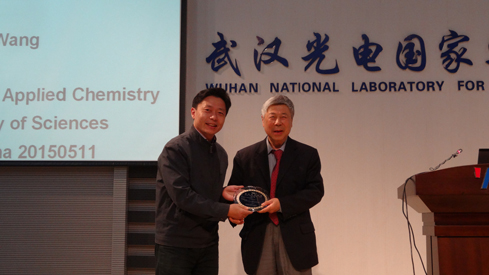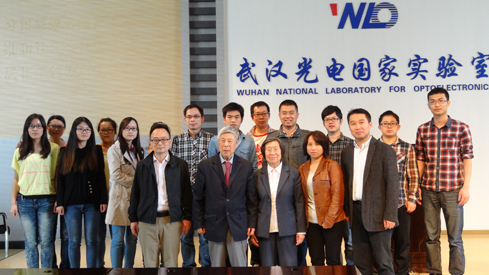WUHAN, China (May 11, 2015) - Wuhan Optoelectronics Forum No. 96 was successfully held in Auditorium A101 at Wuhan National Laboratory for Optoelectronics (WNLO) in the morning of May 11.
Silver nanoclusters have attracted much research interest because of their unique size-dependent optical, electronic, magnetic, and catalytic properties. Our group has focused on the detection of DNA, Hg2+ and biothiols based on DNA protected silver nanoclusters. We have reported photoinduced electron transfer (PET) between DNA/Ag NCs and G-quadruplex/hemin complexes, accompanied by a decrease in the fluorescence of DNA/Ag NCs. The novel PET system enabled the specific and versatile detection of target biomolecules such as DNA and ATP with high sensitivity. Recently, we have developed a high-yield synthesis of silver nanoclusters using DNA monomers as the scaffolds for the first time. In the study, we have explained the mechanism of the formation of DNA-protected silver nanoclusters and the reason why cytosine-rich DNA strands are good scaffolds for fluorescent silver nanoclusters by using density-functional computations. Our results provide basic guidelines for further experimental and theoretical studies on DNA-protected fluorescent silver nanoclusters and may ultimately contribute to the programmed synthesis of DNA-stabilized silver nanoclusters with photoluminescence properties.
Erkang Wang graduated in chemistry at the University of Shanghai (1952). Ph.D. degree received in Prague from the Czechoslovak Academy of Sciences in 1959 under Professor J. Heyrovsky, Nobel Prize laureate. He is a member of CAS (1991) and of the Academy of Sciences for the Developing World (TWAS)(1993), Honorary Member of the Japanese Analytical Chemistry Society (2006). He is editor-in-chief of Analytical Chemistry (Chinese). He was previously deputy director and director of CIAC, CAS. His awards include: National Science Congress Award; 5 CAS Awards; 5 Awards and 1 Special Outstanding Award in Jilin Province; 3 National Natural Science Awards; first winner of the 10th Kharazmi International Festival, Tehran, Iran; and the World Intellectual Property Organization, Geneva, 1997, and 40 invention patents. He gave over 100 plenary, key and invited lectures in international symposia, and over 200 seminars and reports in 26 countries and regions. He has being directed 13 postdocs and over 100 graduates, and among them 3 received national hundred excellent doctorate thesis awards, 2 received special President awards and 4 received excellent doctorate thesis awards of CAS. He has been awarded as an excellent graduate supervisor many times in CAS. He is known for his advancements in bioelectrochemistry, sensors and biosensors, hyphenated interface with separation technics, microfluidics and electroanalytical chemistry. He published about 800 papers in intenational SCI journals cited over 25,000 times with H index of 77. He is selected in the global "Highly Cited Researcher 2014" by ISI Web of Science (SCI) in the past 11 years (2002-2012).

